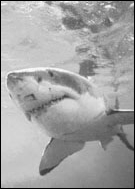 | |||||||||||
|
|
|
|
|
|
|
||||||
|
| |||||||||||
by Richard Schmidt The following is the second of three parts of a discussion I recently had with Sean Van Sommeran, the Operations Director of the Pelagic Shark Research Foundation (PSRF) located in Santa Cruz. Rs: With this [area] being dubbed the "Red Triangle", you would think there would be a lot more attacks. Sv: Sharks have been studied over the years in a baited context. Humans would go to an area, pour blood in the water, and the sharks would come up all agitated and hungry and that would be the publics perception of them. Pictures and videos [have been] taken. For instance, "Blue Water White Death", which was kind of a hallmark movie representing a very artificial and narrow window of what the White shark is all about. Actually, there are a lot more dangerous sharks [than the White]. The Bull and Tiger sharks bite a lot more people than Great Whites, and they appear to be a lot more indiscriminate in feeding and devouring. Great Whites seem to be very selective. They'll bite a lot of different things but won't consume them. Mechanically, [the Great White is] certainly the most imposing. It is big and it's the world's largest predatory fish. It's certainly capable of doing all the things that they are depicted of doing in the movies but, statistically speaking, it's really not the most dangerous shark. In our studies, we've found that it seems they often go for weeks without eating. Rs: Why would they not eat for that long, would it possibly be lack of opportunity? Sv: We don't understand that. Because they linger in the area, we'll see them day after day and not witness any feeding events. The weakness in that observation is [that] they may be feeding at night or we may just be missing it. We've observed one specific White this year feeding 3 separate times but with a long interim in-between, [even though it was] present in the area the whole time. What keeps it in the area when it's not hungry? What keeps it from wandering elsewhere and then coming back to the kitchen when it's hungry? It seems to kind of just hand around in-between feedings. There's probably some other social interaction going on. Perhaps they're paring up or mating, which is an ambitious assumption. But there's something other than feeding going on. There's something other than feeding going on, but we're not sure what it is. |
| |
[ home ] | [ contact us ] | [ support us ] | [ shop ] | © Copyright 1990-2005 PSRF All rights reserved. |
Site Development by IT Director |
 Tracking Great Whites
in The Red Triangle - Part 2
Tracking Great Whites
in The Red Triangle - Part 2